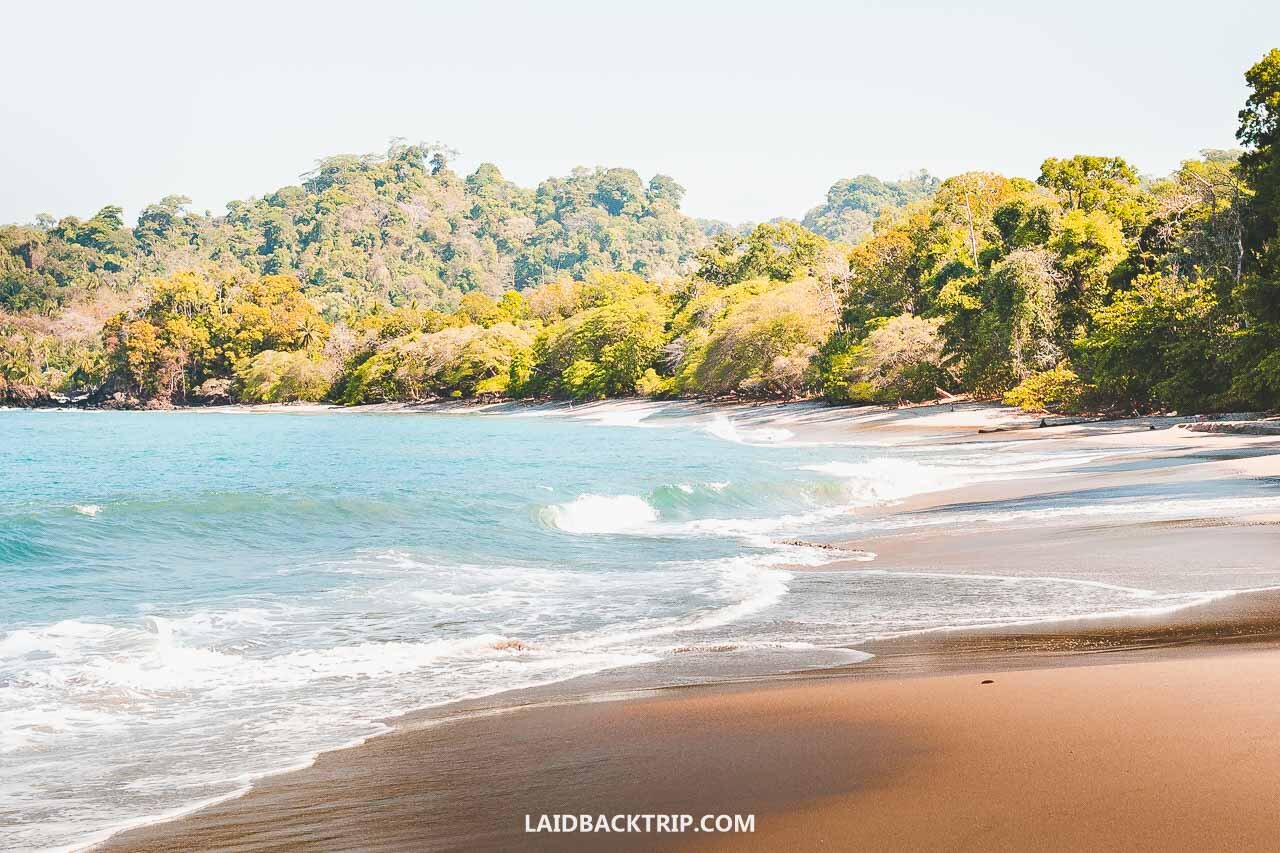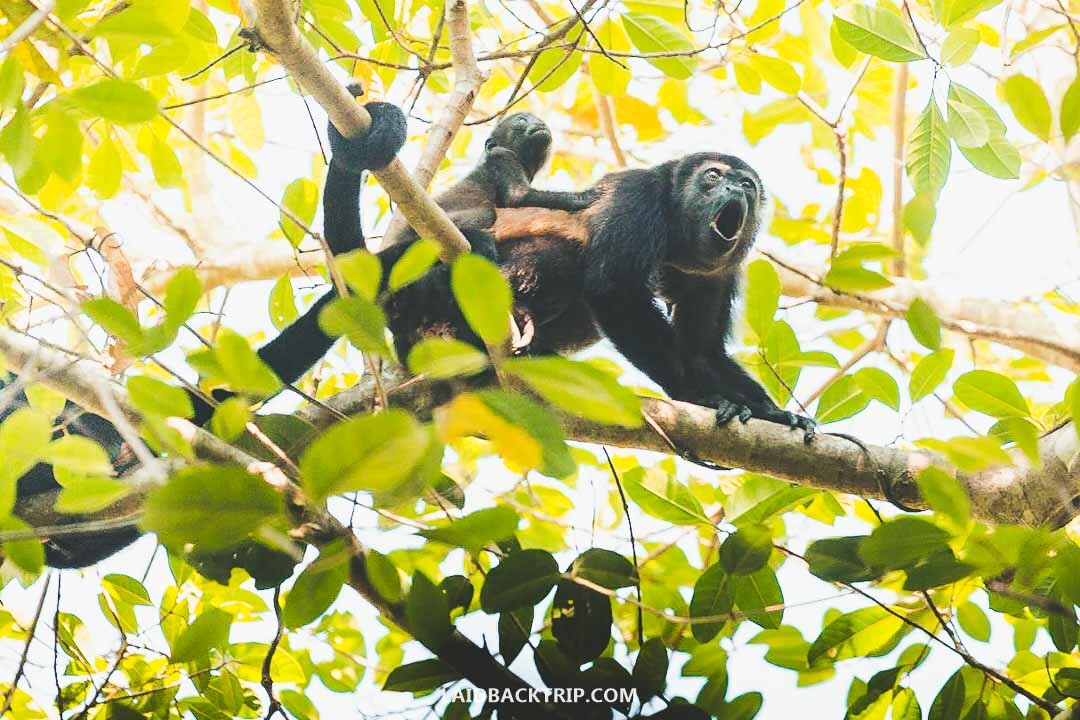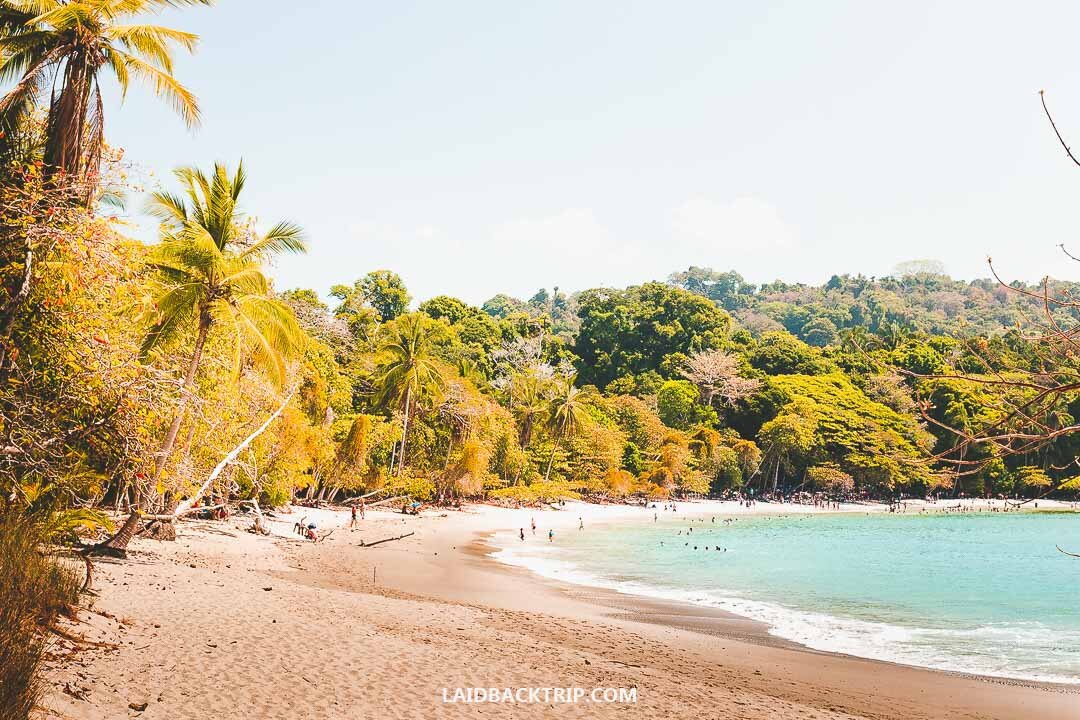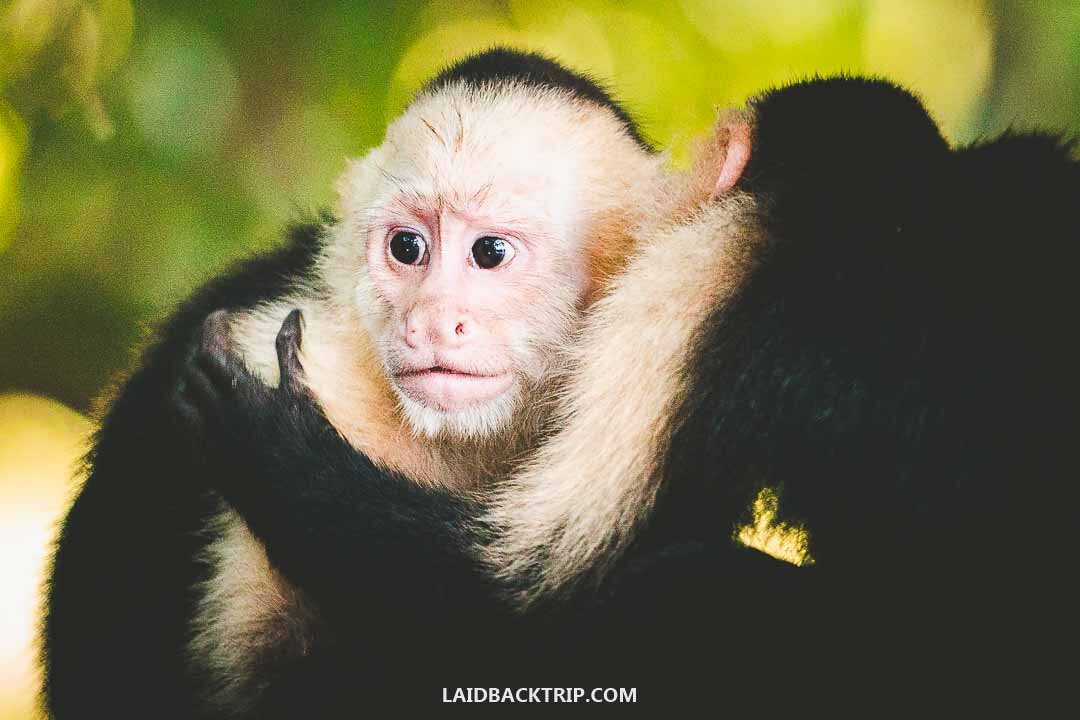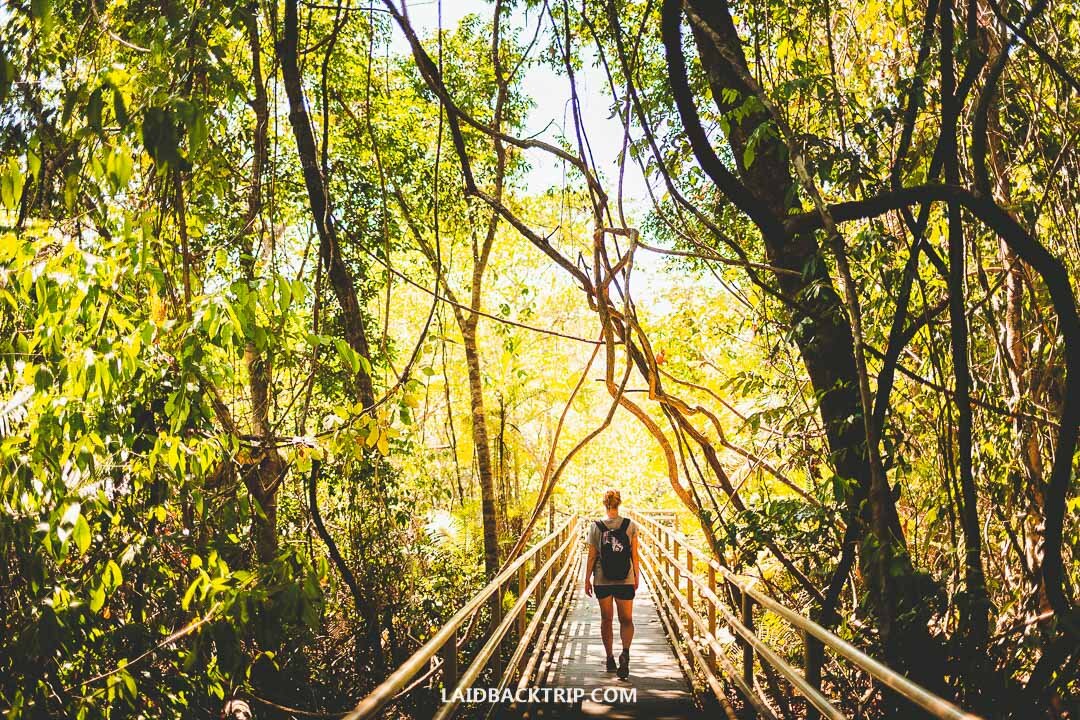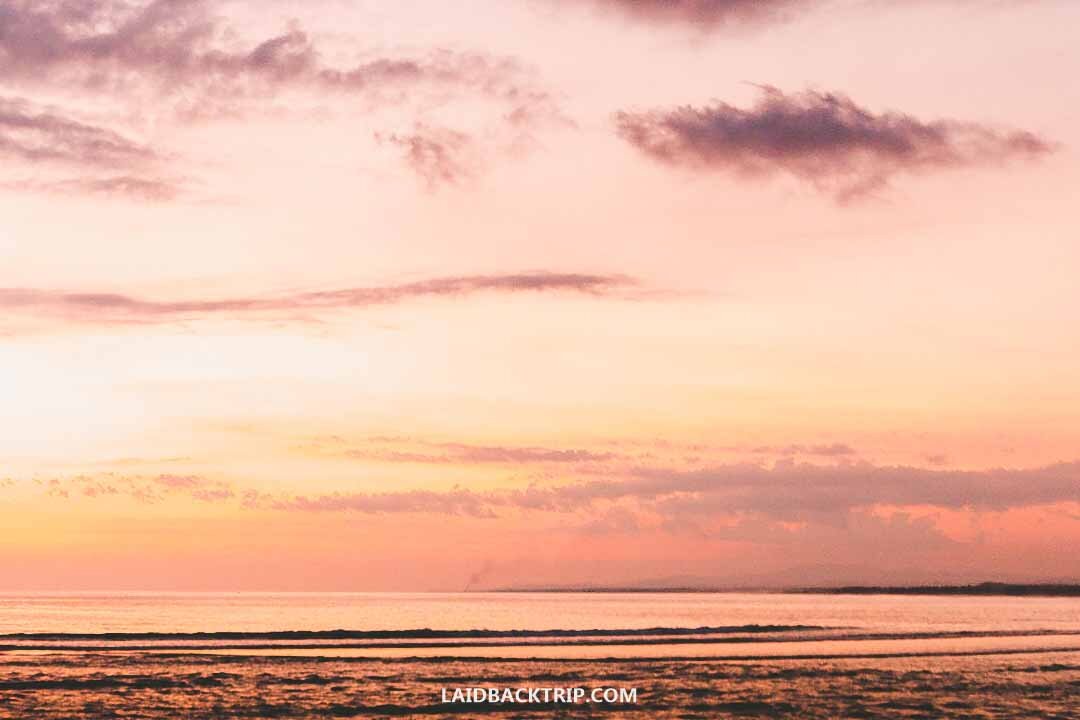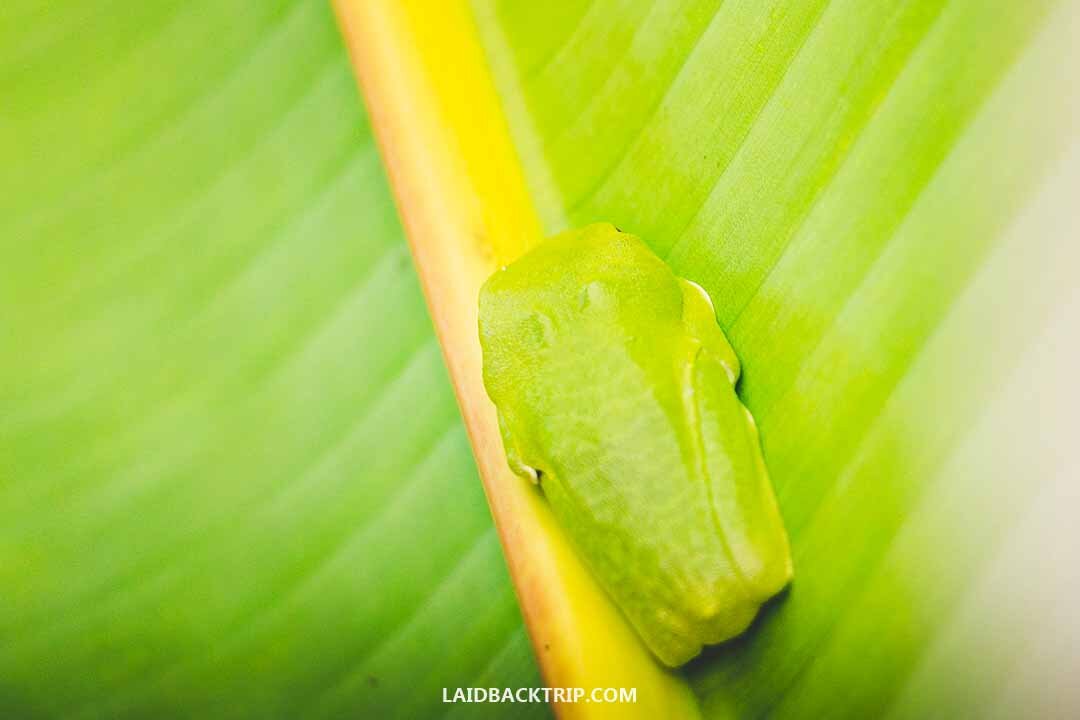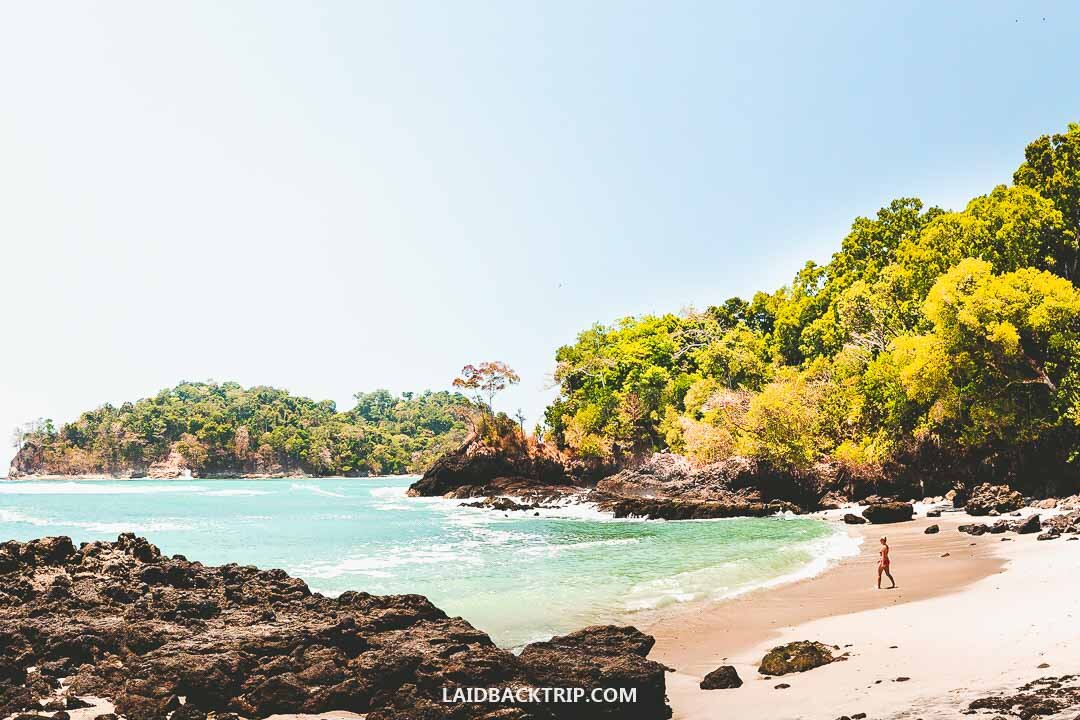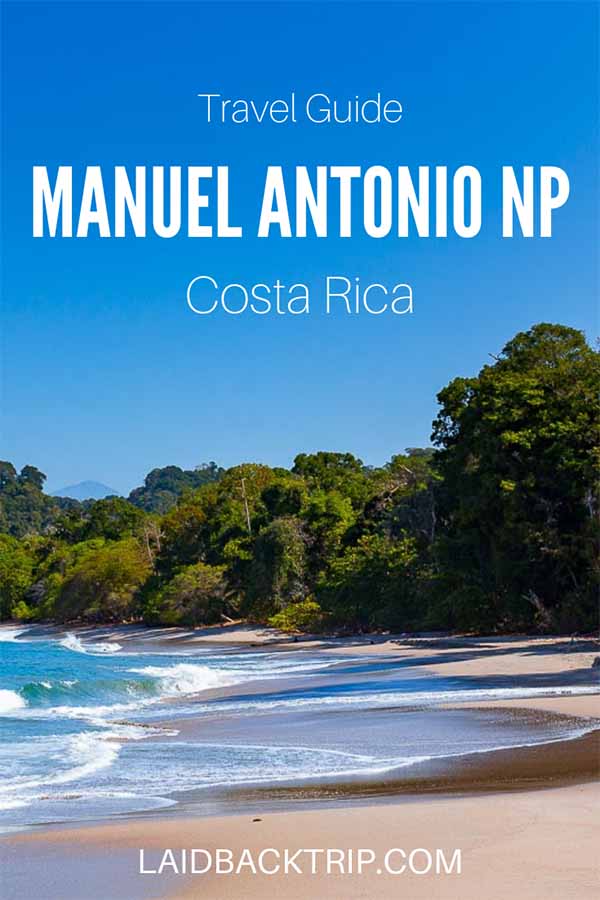A Complete Guide to Manuel Antonio National Park, Costa Rica
Manuel Antonio National Park is the smallest yet most heavily visited national park in Costa Rica. Is this place the real gem worth visiting, or should you better skip it? Read our Manuel Antonio National Park travel guide that includes all the essential information on things to do, how to get, how much things cost, when is the best time to visit, what to pack, or where to stay.
For many, visiting the Manuel Antonio National Park is among the best thing to do in Costa Rica. But our first impression of the park was nothing to write home about.
You see, traveling long-term has many advantages, but also brings several cons when we compare this travel style with a regular two or three weeks holidays. And how this topic cohere with our trip to Manuel Antonio National Park, a top attraction on the Pacific side of Costa Rica? Just hang in there.
For us, the biggest downside is the lack of planning and doing proper research, as we would have done normally when preparing for a shorter vacation. There are many reasons why we don't plan much ahead anymore when on the road, some more significant than others.
Reason number one, unfortunately, we don't have much time to do it because of ongoing work on our blog which requires a lot of sitting behind the desk (we do not complain, though). The reason number two, we probably became a bit lazy, and reason number three, we found out that if we miss a thing or two or if we see a place sooner or later, nothing will actually happen.
So what a surprise when we arrived in Quepos, a base for visiting Manuel Antonio National Park, and started to read the latest reviews about the park. Plenty of them from the past couple of months was negative, and for a moment or two, we were even thinking not to travel to the park at all.
We must admit that we did not expect that, as until that time, we considered Manuel Antonio National Park among the must-visit places in Costa Rica. This was a huge wake-up call for us, and we again realized that there's nothing better than having our own real experience.
Sure, comments and reviews are often helpful, but only a personal experience, the right mindset, and a general idea of what to expect can prepare travelers for visiting a new destination.
In the end, we (thankfully) decided to give visiting this diverse national park that offers a unique combination of jungle, wildlife, and beaches a try, and in this travel guide, we bring everything you need to know before visiting Manuel Antonio National Park.
We sincerely believe that this post will inspire you to include Manuel Antonio in your itinerary, but as we've mentioned, there are a few things every traveler needs to know.
To enjoy the trip to the fullest, we believe that information on how to get to the park, when is the best time to visit, how much things cost, or advice on whether it is necessary to hire a guide will come in handy.
MANUEL ANTONIO
Before you start planning your trip, it is good to set the park's location into perspective.
First of all, it is necessary to know that the national park is very easily accessible from the capital San Jose, but basically from the whole of Costa Rica, thanks to being one of the country's top destinations on the Pacific Coast.
You have a few options on where to base yourself (more about it in the accommodation section), but it is important to know that there is Manuel Antonio park and a village that carries the same name, which is on the way to the park.
Manuel Antonio is rather a stretch of houses along the road than a village, but still, it is one of Costa Rica's top destinations, where hotels sell out fast.
The location close to the rainforest, unspoiled beaches, proximity to the famous national park made this place one of the most sought-after places in Central America, and prices, unfortunately, reflect this trend.
The positive news is that this is not the only alternative on where to stay, it is completely fine to visit the park from nearby Quepos, which is exactly what we did.
MANUEL ANTONIO NATIONAL PARK
One of the things to know about Costa Rica is that it's a country with incredible biodiversity.
If you want to see the best of what this pearl of Central America has to offer, head to Manuel Antonio National Park, where you can admire lush green jungle, pristine white sand beaches, amazing ocean views, look for wildlife, and overall enjoy the perfect day out.
The only problem is that the word about the park's exceptionality has already spread out, and you won't be the only person heading this direction when in Costa Rica.
Yes, over-tourism and crowds are definitely a problem in Manuel Antonio, same as, for example, on the Rainbow Mountain in Peru, but who could blame others who want to see such an extraordinary place as many people before them?
We are definitely not travelers who visit a popular destination and then complain about crowds - on the other hand, we would rather search for alternatives and ways to visit to enjoy our time fully.
We have advice, though. Suppose you prefer exploring places off the beaten path and a large number of tourists at one place upset you.
In that case, you won't have a problem finding a similar, not-so-popular not-so-touristy park in Costa Rica. However, we still think that skipping Manuel Antonio National Park would be a mistake.
HOW TO GET TO MANUEL ANTONIO NATIONAL PARK
Manuel Antonio National Park is well-connected with other tourist destinations within Costa Rica, so you have plenty of options for visiting the park.
There is a public bus from the capital city, San Jose and other major tourist destinations, but we think it is worth it to spend the night before the trip in either Quepos or Manuel Antonio village.
You will have to change the bus in Quepos anyway (in case you travel by public transport). Here's the list of options on how to get to Manuel Antonio park.
RENTAL CAR
So far, the most popular way to travel around Costa Rica is by car rental. This way, you can drive all the way almost to the park's gate without bothering about bus schedules.
Renting a car in Costa Rica is definitely the most comfortable alternative. It is worth seeing the bigger picture and creating your Costa Rica itinerary before deciding on either traveling in the car or public transport.
If you have a car, you might be interested in parking options.
There is a small parking lot close to the entrance which tends to fill up early in the morning and costs 3000 colones per day.
In the past, there were lots of parking scams going on, so when the park's parking is full, your best bet is to drive to Hotel Manuel Antonio at the end of the road where you can park your car on a secured parking lot for the same price, 3000 colones per day.
TOURS
If traveling independently is not your thing or this time it simply makes sense to visit Manuel Antonio with a tour, the good news is that you can arrange a day tour from several tourist destinations within Costa Rica.
The most popular places where you can base yourself and visit Manuel Antonio National Park without arranging your transport are San Jose or Jaco. Taking a tour also has advantages, the biggest one is a knowledgeable guide and a stress-free day.
Manuel Antonio Tour from San Jose includes hotel pickup and drop-off.
PUBLIC TRANSPORT
It is easy to reach Manuel Antonio National Park by public transport, which is good news for all budget travelers. First, you need to get to Quepos, the closest town to the park, which is well-connected with Uvita, Jaco, or San Jose.
In Quepos, you need to take a regular bus that leaves approximately every 30 minutes from the bus terminal to the park.
The seven kilometers long ride takes less than 30 minutes and costs 350 colones per person one way. The first bus leaves at 5:30 AM, so you don't need to be worried you won't make it for the opening.
The bus stops along the way to the park if you are staying in one of the hotels lining the road on the way to Manuel Antonio National Park.
ENTRANCE FEE
To get to Manuel Antonio National Park, we had to pay $16 each, which is quite a lot, and what we found the most annoying is that locals often pay six times or seven times less. We were used to paying double than locals in South America, but the difference here seemed way too big.
Simply put, tickets to Manuel Antonio National Park are the chapter on its own. Moreover, we must say that we found all the entrance fees to national parks in Costa Rica overpriced (for example, the entrance fee to Monteverde Cloud Forest cost $22).
Anyway, even though we consider ourselves budget travelers, we wanted to see the exceptionality of Manuel Antonio National Park with our own eyes.
Not that long time ago, travelers had to line up in front of the entrance from the very morning to ensure that they will be let in the park as there was a quota of 1700 visitors daily to the park and only 600 people at one time. It was not a very good system.
First of all, it was tiring of waiting by the gate under the harsh sun and secondly, it was quite frustrating for holidaymakers on a strict schedule who arrived a bit late.
In our case, we had to line up in front of the entrance before 7 AM as we did not know that a presale exists. It was actually possible to buy a ticket online back then, but this option was not very popular.
TICKETS
Nowadays, the conditions are different, and travelers must purchase the ticket in advance for a specific timeslot. It is basically impossible to show up without an online reservation as you'll be asked to book the ticket online anyway.
The reservation must be created via an official government website SINAC, where you have to create an account, choose the buy option and then select an online reservation.
Then the process is simple, select the national park, in our case Manuel Antonio National Park, next choose what time slot suits you the best (we think the earlier you go, the better), select the number of visitors, and the next step is the completion of the payment.
There are designated time slots to enter the park between 7 AM and 11 AM.
OPENING HOURS
The park is open every day of the year except on Tuesday from 7 AM to 4 PM. It is also open during holidays if the day doesn't fall on Tuesday.
We think it is pretty significant news that the park is not open every day in a week, and it should be emphasized more than it is nowadays to avoid the disappointment of many travelers.
It is also super-important for planning the perfect Costa Rica itinerary.
Also, the beaches close at 3 PM, which is also when the park's staff starts reminding people about closing time. As you can see, the time for visiting the park is quite limited; therefore, we would recommend you booking the morning time slot.
THINGS TO KNOW BEFORE VISITING MANUEL ANTONIO NATIONAL PARK
The busiest season in Costa Rica is between November and March, which is also when you should consider booking the ticket more seriously; the situation in the rainy season is a bit calmer and not that crowded.
What else should you know before visiting Manuel Antonio National Park? Take plenty of water with you as the weather is often very hot and humid. We had 6 liters and drank it all, even though it seemed like overkill at first.
Also, you can take a snack with you, but no nuts and seeds - your bag will be searched at the entrance gate. The rules are basically very similar to airports.
There is a small shop in the middle of the park where you can buy some snacks and water, but no real food.
We think it is important to know what to expect from visiting the park - it is the only way how to avoid disappointment. The park is simply stunning, and we certainly enjoyed our visit - the beaches are beautiful, and you will see many animals, but you must accept that you will share the place with others.
The first impression was quite negative, even intimidating because of many people near the entrance and at the beginning of the trail, but after a while, crowds dispersed, and we could focus only on searching for wildlife and on looking for the best beach to relax on.
Do not leave your bags unattended on a beach, especially when you have food in them. There are lots of monkeys and raccoons waiting to steal your food, and you would be doing a disservice to them by feeding animals, although unintentionally - you can always ask someone to watch your bag.
BEST THINGS TO DO IN MANUEL ANTONIO NATIONAL PARK
The park offers plenty of activities, and we found it quite challenging to do everything we wanted within nine hours when the park is open, especially when we take into account Costa Rica's terrible humidity, which makes everything much more exhausting.
We've already mentioned that Costa Rica has many national parks, and it is often hard to say which one is the best. But we can with certainty say what makes Manuel Antonio so special.
Sure, it has beautiful nature and photogenic wildlife to admire, but we saw its potential in a perfect mix of staying active and relaxing, and it is only up to you what you decide to do.
Here's a list of the top things to do in the Manuel Antonio National Park.
HIKING
Manuel Antonio National Park has many hiking trails, and it is possible to dedicate the whole day to explore them. There's a map of hiking trails on almost every junction in the park, so it is impossible to get lost.
We've done them all, and probably the favorite hike was the loop you can make from Playa Manuel Antonio, but other trails were excellent as well.
All hikes within the park are for all ages and abilities. Note that the waterfall in the park is only seasonal, and in March, there was no water running down at all, but it is a place where you can look for snakes and frogs.
All trails usually lead on boardwalks and are not challenging, but there are some sections where you will have to climb up and down, and it is good to know if you have mobility issues. In this case, you might need hiking poles.
WILDLIFE WATCHING
It was fun looking for the wildlife in Manuel Antonio National Park, and the day we went, it was not particularly hard to spot animals, but every day is different. Be patient, and listen quietly to discover sloths, birds, or monkeys.
We were actually positively surprised that despite the number of visitors, animals were still very close to trails, and we could capture them with, but sometimes even without, our telephoto lens. On the other hand, for better views, it is definitely worth it to bring binoculars.
If you are an enthusiast photographer, bring proper gear. A camera such as Canon EOS R6 with an animal eye focus paired with Canon RF 100-500mm F4.5-7.1 will deliver superb results.
BEACHES
If you are looking for a place to unwind, Manuel Antonio National Park is the destination you are looking for. There are several pristine beaches in the park where you can spend all day long.
Honestly, we wouldn't pay the steep entrance fee only to lie down on a beach - there are so many pretty beaches outside the park or in other parts of Costa Rica where you don't have to pay at all.
On the other hand, the beaches in the park are very eye-catching, and you must forgive them the fact that swimming is usually forbidden because of dangerous currents.
CATAMARAN CRUISE
If you want to enjoy waters around the national park, see crocodiles, whales (depending on the season), and snorkel, you can check out the Catamaran Cruise.
It is a bit an unusual way to spend time in Manuel Antonio National Park, and if you are looking for an extraordinary activity, this might be it.
MANGROVES KAYAKING
Mangroves Kayaking Tours are pretty popular in many places around the world, such as in Paraty in Brazil or Bocas del Toro in Panama, and you can enjoy it even here in Costa Rica if you are looking for a way how to actively spend your day.
Mangroves are super-important for the world's ecosystem, and Damas Island near Quepos is a great spot to see mangroves and animals living there up close. Even though this activity takes place not within the national park, we believe it's worth it.
ZIPLINING
There is an adventure park in Manuel Antonio where you can try different adventure activities such as zip lining, ATVs or rappelling.
We've done canyoning in Jaco, Costa Rica, and can only recommend trying it.
Travel Insurance
We never leave home without travel insurance that was designed to cover our expenses if something goes wrong during the trip.
Travel insurance protects against theft, flight delays, injury, illness, cancellations, and much more.
World Nomads provides travel insurance for travelers to cover their trip essentials, including sports and adventure activities.
SafetyWing is affordable travel insurance for backpackers, long-term travelers, and digital nomads.
Travel smarter and safer!
ANIMALS IN MANUEL ANTONIO
Wildlife watching is without doubt one of the top activities available in the park, which definitely deserves mentioning. The abundance of animals and various species is hard to believe, so your expectations should be high.
The best time to see wildlife in the park is early in the morning, later in the afternoon, and when it does not rain, but we think you will always spot at least sloths and monkeys.
What animals should you expect to see in Manuel Antonio National Park? For sure, sloths, hanging lazily on tree branches, several species of monkeys such as howler monkeys, capuchin monkeys or squirrel monkeys, birds, insects, frogs, snakes, iguanas, and much more.
When lucky, you can also spot migrating whales and dolphins offshore; the best season is from December to March.
VISITING THE PARK WITH A GUIDE VS. INDEPENDENTLY
Manuel Antonio National Park is a heaven for families with young kids, for the elderly, but also young independent travelers or millennials, even though it is evident that each of these groups has a different travel style and budget.
TAKING A GUIDED TOUR
If you are really keen to see the wildlife, and if this is for you the main motivation to visit the park, we recommend you hire a guide.
The guide will point out all animals he can spot during the tour, he knows where to go at what time, and he also has telescopes for better observation. Manuel Antonio Tours usually cost $50. It depends on how many people are in the group and whether the entrance fee is included or not.
You can reserve Manuel Antonio Tour here.
Even when you hire a guide, the tour usually takes four hours, and you will still have a lot of time to walk in the park on your own and enjoy pristine beaches.
VISITING MANUEL ANTONIO WITHOUT A GUIDE
We visited the park independently, and maybe we were only lucky but saw a lot of wildlife that day even without a guide, but we are sure we still missed out quite a lot, for example, it is hard to look for snakes or small insect when you don't know where to look.
But because we already seen places on our year-long trip such as the Peruvian jungle in Pacaya Samiria National Reserve to be specific, wildlife watching was for us only a nice bonus, not the main reason to visit the park.
Sometimes, you can also meet a group with a guide, and you can see that they are looking at something which can be helpful, but remember you chose to visit the park independently, so do not linger around too long.
WHERE TO STAY
When visiting Manuel Antonio National Park, you have endless options on where to stay, although cheap options are unfortunately scarce as Costa Rica is not a budget-friendly country.
First, Costa Rica is quite a small country, so if you have a rental car or take a tour, you don't need to stay close to the park, but you can get up early and drive directly to the entrance, or the bus will pick you up.
The closest town to the park where you can stay is Quepos, or another alternative is to find accommodation along the seven kilometers long stretch of road leading from Quepos to Manuel Antonio National Park. This place is fittingly called Manuel Antonio.
We think it doesn't matter if you decide to stay in the town or closer to the park, as the bus to the park runs from Quepos via Manuel Antonio village.
Here are the top accommodation options in the Manuel Antonio area for all types of travelers.
Budget | Wide Mouth Frog - Close to everything, the location of this hostel cannot be better. You can find here private rooms and dormitories and a large outdoor swimming pool.
Mid-range | La Foresta Nature Resort - The charming accommodation just outside Quepos has its own swimming pool, rainforest canopy, and zip line and also offers a free beach shuttle.
Luxury | Los Altos Resort - Luxurious suites in Manuel Antonio have a fully-equipped kitchen, balcony, and access to the private beach is among the best features in this hotel.
THE BEST TIME TO VISIT MANUEL ANTONIO
Costa Rica has two distinct seasons - dry and wet. The peak season runs between December and the end of March or mid-April when you can expect dry conditions (it is not uncommon to experience afternoon rain in Costa Rica's dry season, though).
Still, prices and overall tourism are at their peak as well. During those four months, the park can get insanely busy as it receives international travelers and local visitors at the same time. If you want to avoid crowds, try to plan your visit outside this timezone.
The green alias rainy season runs from the end of April to the end of November. You can expect fewer people in the park and frequent showers, especially in the afternoon, so it is definitely better to visit the park in the wet season early in the morning to increase your chances of having nice weather.
The rainiest month of the year is September, when you also have the smallest chance to see the wildlife as it is hiding the same as visitors. When visiting during this month, consider hiring a guide to help you see animals.
WHAT TO PACK
The weather in the park is hot and humid throughout the year, and temperatures often sit around 30°C - take plenty of water with you!
Costa Rica is one of the few places in Central America where tap water is drinkable. The country also fights against single-use plastic, so bring your reusable water bottle, but if you do not trust tap water, invest in SteriPen, which kills bacteria.
What are other items you should pack? Do not forget a swimsuit, reef friendly sunscreen, and insect repellent. You'll be swimming and sweating, so it is necessary to reapply sunscreen and repellent during the day.
Make sure you have a comfortable daypack and trail runners.
Travel Resources
Here you can find links to all the travel resources we use and which you might find helpful when planning your next holiday.
Accommodation: When looking for accommodation, we usually search hotels via Booking.com or Hostelworld.
Tours: Although we love to travel independently, some places are better to visit with a guided tour.
We prefer GetYourGuide for its easy-to-use interface and solid reputation. Another great alternative is Viator.
Rental Cars: When going on a road trip, we always use Rentalcars.com, a reliable site for booking a rental car in advance.
Flight Tickets: When looking for flight tickets, you can search Skyscanner to find the best price.
Travel Insurance: World Nomads and SafetyWing cover against risks of travel.
